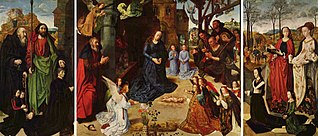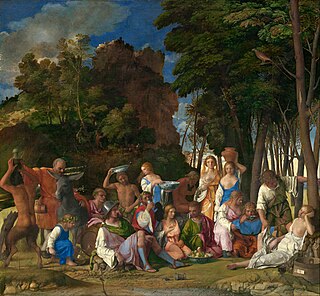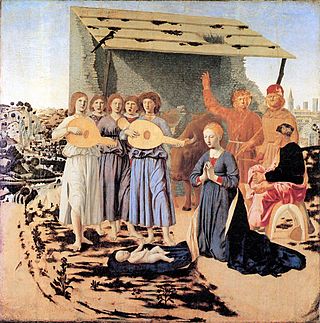
Andrea Mantegna was an Italian Renaissance painter, a student of Roman archeology, and son-in-law of Jacopo Bellini.

The Adoration of the Magi or Adoration of the Kings or Visitation of the Wise Men is the name traditionally given to the subject in the Nativity of Jesus in art in which the three Magi, represented as kings, especially in the West, having found Jesus by following a star, lay before him gifts of gold, frankincense, and myrrh, and worship him. It is related in the Bible by Matthew 2:11: "On entering the house, they saw the child with Mary his mother; and they knelt down and paid him homage. Then, opening their treasure chests, they offered him gifts of gold, frankincense, and myrrh. And having been warned in a dream not to return to Herod, they left for their own country by another path".

BartolomeoMontagna was an Italian Renaissance painter who mainly worked in Vicenza. He also produced works in Venice, Verona, and Padua. He is most famous for his many Madonnas and his works are known for their soft figures and depiction of eccentric marble architecture. He is considered to be heavily influenced by Giovanni Bellini, in whose workshop he might have worked around 1470. Benedetto Montagna, a productive engraver, was his son and pupil and active until about 1540. He was mentioned in Vasari's Lives as a student of Andrea Mantegna but this is widely contested by art historians.

The Holy Family consists of the Child Jesus, the Virgin Mary and Saint Joseph. The subject became popular in art from the 1490s on, but veneration of the Holy Family was formally begun in the 17th century by Saint François de Laval, the first bishop of New France, who founded a confraternity.

The Portinari Altarpiece or Portinari Triptych is an oil-on-wood triptych painting by the Flemish painter Hugo van der Goes, commissioned by Tommaso Portinari, representing the Adoration of the Shepherds. It measures 253 x 304 cm, and is now in the Galleria degli Uffizi in Florence, Italy. This altarpiece is filled with figures and religious symbols. Of all the late-fifteenth-century Flemish artworks, this painting is said to be the most studied.

The Adoration of the Shepherds is the traditional name for a New Testament episode in the story of Jesus's nativity, which is the subject of many works of art. In it shepherds are near witnesses to Jesus's birth in Bethlehem, arriving soon after he is actually born. The episode is recounted, or at least implied, in the Gospel of Luke and follows on from the annunciation to the shepherds, in which the shepherds are summoned by an angel to the scene of the birth. Like the episode preceding it, the adoration is a common subject in art, where it is often combined with the Adoration of the Magi. In such cases it is typically just referred to by the latter title.

The Lamentation of Christ is a painting by the Italian Renaissance artist Andrea Mantegna. It portrays the body of Christ supine on a marble slab. He is watched over by the Virgin Mary, Saint John and St. Mary Magdalene weeping for his death. While the dating of the piece is debated, it was completed between 1475 and 1501, probably in the early 1480s. The painting is currently at the Pinacoteca di Brera in Milan.
The decade of the 1450s in art involved many significant events, especially in sculpture.

This article about the development of themes in Italian Renaissance painting is an extension to the article Italian Renaissance painting, for which it provides additional pictures with commentary. The works encompassed are from Giotto in the early 14th century to Michelangelo's Last Judgement of the 1530s.

The Feast of the Gods is an oil painting by the Italian Renaissance master Giovanni Bellini, with substantial additions in stages to the left and center landscape by Dosso Dossi and Titian. It is one of the few mythological pictures by the Venetian artist. Completed in 1514, it was his last major work. It is now in the National Gallery of Art in Washington D.C., which calls it "one of the greatest Renaissance paintings in the United States".

The Adoration of the Shepherds, sometimes still known as the Allendale Nativity, after a former owner, is a painting by the Italian Renaissance painter Giorgione, completed in about 1505 to 1510. The attribution is now usual, although not universal; the usual other view is that it is an early Titian. It is certainly a Venetian painting of that period. It is displayed in the National Gallery of Art of Washington, D.C., United States.

The Nativity of Jesus has been a major subject of Christian art since the 4th century.

The Ovetari Chapel is a chapel in the right arm of the Church of the Eremitani in Padua. It is renowned for a Renaissance fresco cycle by Andrea Mantegna and others, painted from 1448 to 1457. The cycle was destroyed by an Allied bombing in 1944: today, only two scenes and a few fragments survive, which have been restored in 2006. They are, however, known from black-and-white photographs.

The Madonna della Vittoria is a painting by the Italian Renaissance painter Andrea Mantegna; the painting was executed in 1496.

The Parnassus is a painting by the Italian Renaissance painter Andrea Mantegna, executed in 1497. It is now in the Musée du Louvre, Paris.

Andreas Ritzos also known as (Andreas Rico, Ricio or Rizo) was a Greek icon painter from Crete. Ritzos is considered one of the founding fathers of the Cretan School. He was affiliated with Angelos Akotantos. Most of his work stylistically follows the traditional maniera greca. His children, grandchildren, and great-grandchildren were also painters. He was one of the most influential painters of the Cretan School along with Andreas Pavias and Angelos Akotantos. He influenced the works of Georgios Klontzas, Nikolaos Tzafouris, Theophanes the Cretan, Michael Damaskinos and El Greco. According to the Institute for Neohellenic Research, sixty of his paintings have survived.

The Bladelin Altarpiece, or Middelburg Altarpiece, is a triptych painting created around 1450 by the Early Netherlandish painter Rogier van der Weyden, towards the end of his artistic career. It depicts scenes relating to the birth of Jesus; and as the only nativity scene definitively attributed to van der Weyden is sometimes known as the Nativity Triptych.

Holy Family with a Shepherd is an oil on canvas painting by Titian, from c. 1510. It is held in the National Gallery, in London. It has also previously been attributed to Anthony van Dyck, who produced a drawing copying it. After passing through other private collections, it was bequeathed to the National Gallery by William Holwell Carr in 1831.

The Pinacotecta Nazionale is an art gallery in Ferrara, Emilia-Romagna, Italy. It is located on the piano nobile of the Palazzo dei Diamanti, a work of Renaissance architecture by Biagio Rossetti, commissioned by Leonello d’Este in 1447. Not to be confused with the Civic Museum on the lower floor, which has hosted temporary exhibitions of contemporary art since 1992, the Pinacoteca houses a collection of paintings by the Ferrarese School dating from the thirteenth to the eighteenth centuries. It was founded in 1836 by the Municipality of Ferrara after Napoleon's widespread dissolution of churches threatened the protection of important public artworks. The gallery is formed as much around notable northern Italian painters as it is around the exquisite interior decoration of the palace itself, together with remnants of frescoes from local churches and later acquisitions from the Sacrati Strozzi collection.

The Nativity is an oil painting by Italian Renaissance artist Piero della Francesca, dated to 1470–75. The painting depicts a scene from the birth of Jesus, and is one of the latest surviving paintings made by the artist before his death in 1492. Held by the National Gallery in London, it measures 124.4 cm × 122.6 cm. It is a popular image on Christmas cards.



















